Analysis of Leadership's Role in Fostering Learning Organizations
VerifiedAdded on 2023/02/01
|7
|1972
|65
Essay
AI Summary
This essay delves into the critical role of leadership in building learning organizations. It emphasizes that effective leadership is essential for creating a shared vision, empowering employees, and fostering a culture of continuous learning and innovation. The essay discusses the characteristics of leaders in learning organizations, including their roles as designers, stewards, and teachers. It highlights the importance of emotional intelligence, communication, and the ability to adapt to change. The essay also explores various leadership styles, such as transformational and servant leadership, and their impact on organizational performance. The conclusion emphasizes the importance of leaders in creating conditions for staff learning and internalizing the habit of continued learning. The essay uses multiple sources to support its arguments.
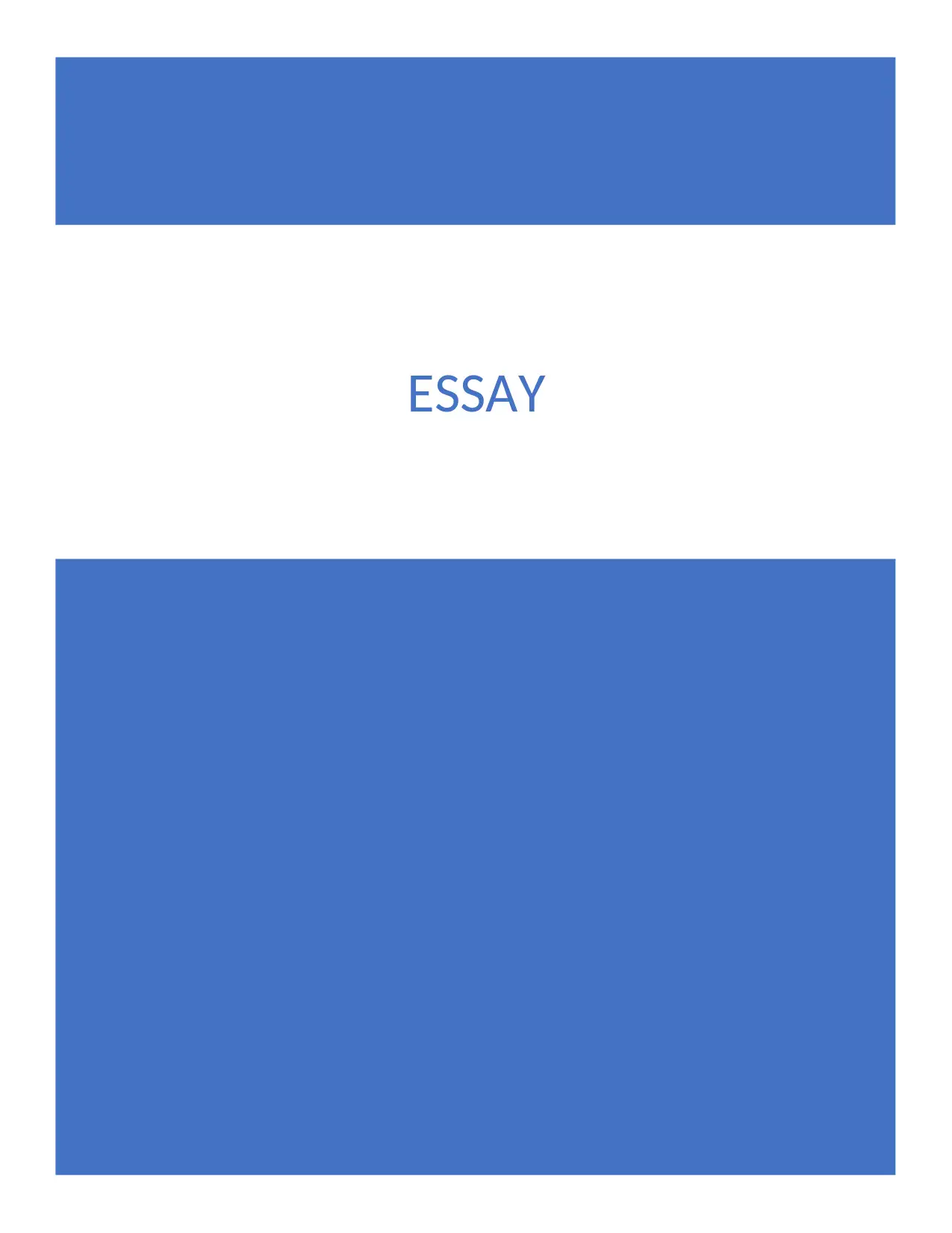
ESSAY
Paraphrase This Document
Need a fresh take? Get an instant paraphrase of this document with our AI Paraphraser
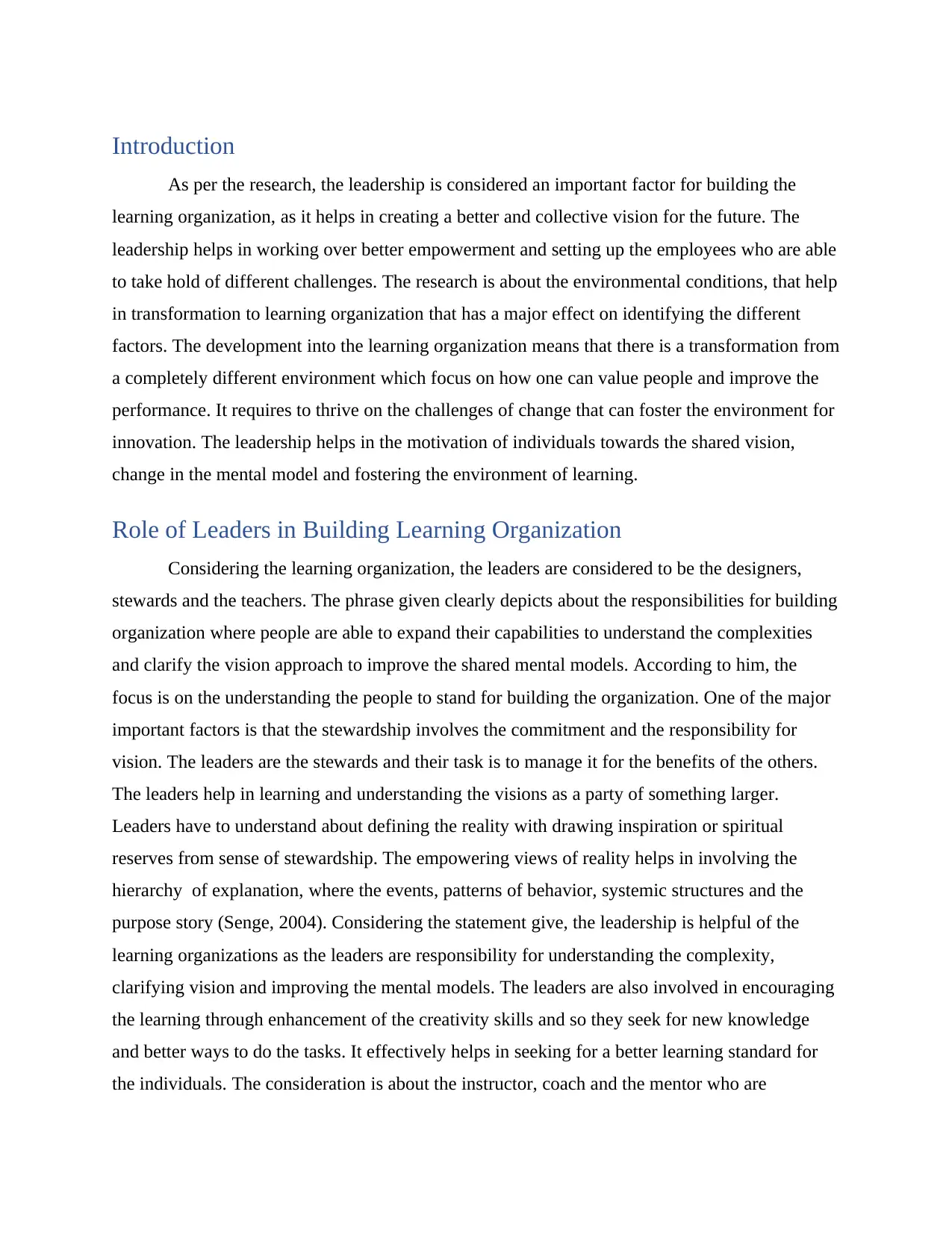
Introduction
As per the research, the leadership is considered an important factor for building the
learning organization, as it helps in creating a better and collective vision for the future. The
leadership helps in working over better empowerment and setting up the employees who are able
to take hold of different challenges. The research is about the environmental conditions, that help
in transformation to learning organization that has a major effect on identifying the different
factors. The development into the learning organization means that there is a transformation from
a completely different environment which focus on how one can value people and improve the
performance. It requires to thrive on the challenges of change that can foster the environment for
innovation. The leadership helps in the motivation of individuals towards the shared vision,
change in the mental model and fostering the environment of learning.
Role of Leaders in Building Learning Organization
Considering the learning organization, the leaders are considered to be the designers,
stewards and the teachers. The phrase given clearly depicts about the responsibilities for building
organization where people are able to expand their capabilities to understand the complexities
and clarify the vision approach to improve the shared mental models. According to him, the
focus is on the understanding the people to stand for building the organization. One of the major
important factors is that the stewardship involves the commitment and the responsibility for
vision. The leaders are the stewards and their task is to manage it for the benefits of the others.
The leaders help in learning and understanding the visions as a party of something larger.
Leaders have to understand about defining the reality with drawing inspiration or spiritual
reserves from sense of stewardship. The empowering views of reality helps in involving the
hierarchy of explanation, where the events, patterns of behavior, systemic structures and the
purpose story (Senge, 2004). Considering the statement give, the leadership is helpful of the
learning organizations as the leaders are responsibility for understanding the complexity,
clarifying vision and improving the mental models. The leaders are also involved in encouraging
the learning through enhancement of the creativity skills and so they seek for new knowledge
and better ways to do the tasks. It effectively helps in seeking for a better learning standard for
the individuals. The consideration is about the instructor, coach and the mentor who are
As per the research, the leadership is considered an important factor for building the
learning organization, as it helps in creating a better and collective vision for the future. The
leadership helps in working over better empowerment and setting up the employees who are able
to take hold of different challenges. The research is about the environmental conditions, that help
in transformation to learning organization that has a major effect on identifying the different
factors. The development into the learning organization means that there is a transformation from
a completely different environment which focus on how one can value people and improve the
performance. It requires to thrive on the challenges of change that can foster the environment for
innovation. The leadership helps in the motivation of individuals towards the shared vision,
change in the mental model and fostering the environment of learning.
Role of Leaders in Building Learning Organization
Considering the learning organization, the leaders are considered to be the designers,
stewards and the teachers. The phrase given clearly depicts about the responsibilities for building
organization where people are able to expand their capabilities to understand the complexities
and clarify the vision approach to improve the shared mental models. According to him, the
focus is on the understanding the people to stand for building the organization. One of the major
important factors is that the stewardship involves the commitment and the responsibility for
vision. The leaders are the stewards and their task is to manage it for the benefits of the others.
The leaders help in learning and understanding the visions as a party of something larger.
Leaders have to understand about defining the reality with drawing inspiration or spiritual
reserves from sense of stewardship. The empowering views of reality helps in involving the
hierarchy of explanation, where the events, patterns of behavior, systemic structures and the
purpose story (Senge, 2004). Considering the statement give, the leadership is helpful of the
learning organizations as the leaders are responsibility for understanding the complexity,
clarifying vision and improving the mental models. The leaders are also involved in encouraging
the learning through enhancement of the creativity skills and so they seek for new knowledge
and better ways to do the tasks. It effectively helps in seeking for a better learning standard for
the individuals. The consideration is about the instructor, coach and the mentor who are
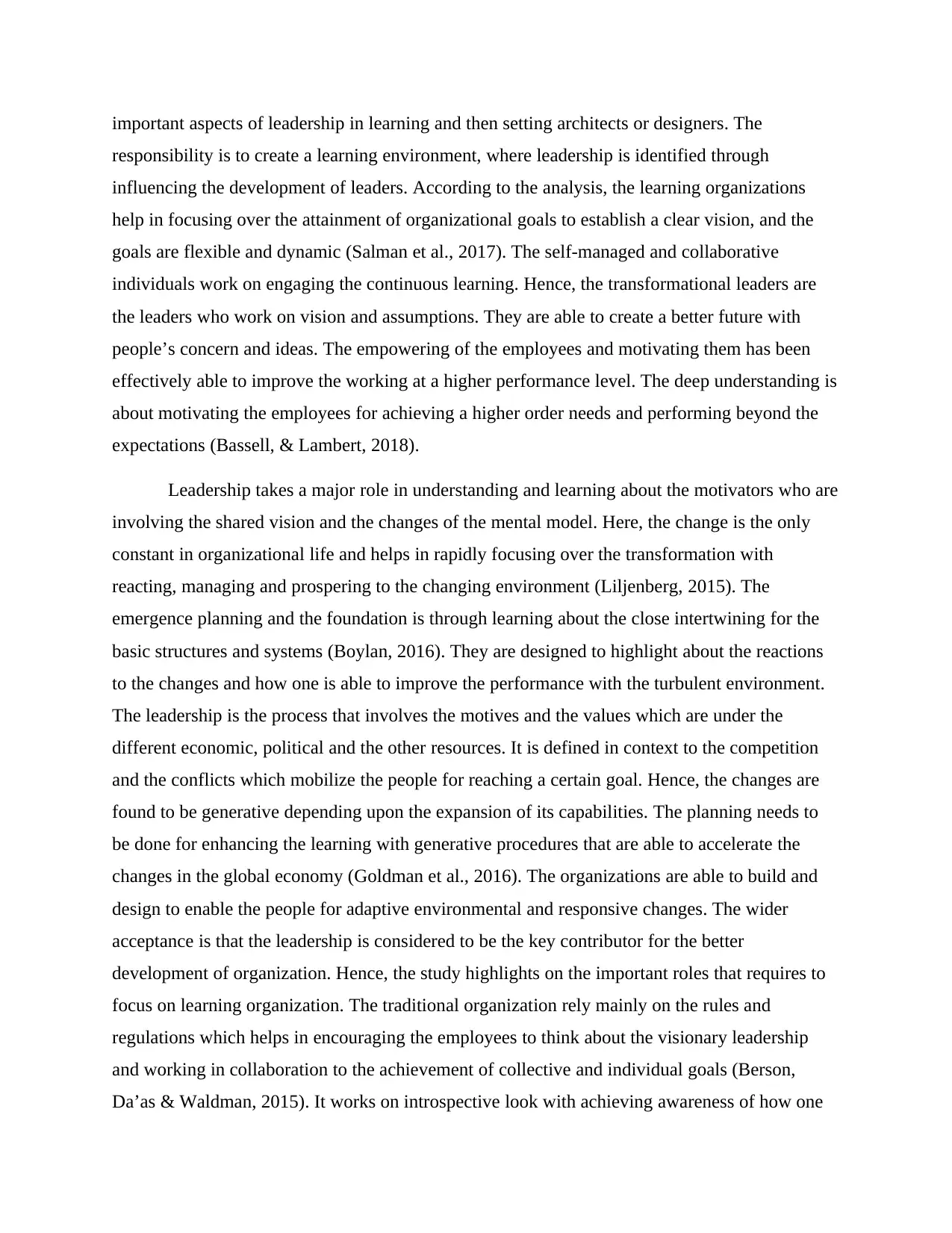
important aspects of leadership in learning and then setting architects or designers. The
responsibility is to create a learning environment, where leadership is identified through
influencing the development of leaders. According to the analysis, the learning organizations
help in focusing over the attainment of organizational goals to establish a clear vision, and the
goals are flexible and dynamic (Salman et al., 2017). The self-managed and collaborative
individuals work on engaging the continuous learning. Hence, the transformational leaders are
the leaders who work on vision and assumptions. They are able to create a better future with
people’s concern and ideas. The empowering of the employees and motivating them has been
effectively able to improve the working at a higher performance level. The deep understanding is
about motivating the employees for achieving a higher order needs and performing beyond the
expectations (Bassell, & Lambert, 2018).
Leadership takes a major role in understanding and learning about the motivators who are
involving the shared vision and the changes of the mental model. Here, the change is the only
constant in organizational life and helps in rapidly focusing over the transformation with
reacting, managing and prospering to the changing environment (Liljenberg, 2015). The
emergence planning and the foundation is through learning about the close intertwining for the
basic structures and systems (Boylan, 2016). They are designed to highlight about the reactions
to the changes and how one is able to improve the performance with the turbulent environment.
The leadership is the process that involves the motives and the values which are under the
different economic, political and the other resources. It is defined in context to the competition
and the conflicts which mobilize the people for reaching a certain goal. Hence, the changes are
found to be generative depending upon the expansion of its capabilities. The planning needs to
be done for enhancing the learning with generative procedures that are able to accelerate the
changes in the global economy (Goldman et al., 2016). The organizations are able to build and
design to enable the people for adaptive environmental and responsive changes. The wider
acceptance is that the leadership is considered to be the key contributor for the better
development of organization. Hence, the study highlights on the important roles that requires to
focus on learning organization. The traditional organization rely mainly on the rules and
regulations which helps in encouraging the employees to think about the visionary leadership
and working in collaboration to the achievement of collective and individual goals (Berson,
Da’as & Waldman, 2015). It works on introspective look with achieving awareness of how one
responsibility is to create a learning environment, where leadership is identified through
influencing the development of leaders. According to the analysis, the learning organizations
help in focusing over the attainment of organizational goals to establish a clear vision, and the
goals are flexible and dynamic (Salman et al., 2017). The self-managed and collaborative
individuals work on engaging the continuous learning. Hence, the transformational leaders are
the leaders who work on vision and assumptions. They are able to create a better future with
people’s concern and ideas. The empowering of the employees and motivating them has been
effectively able to improve the working at a higher performance level. The deep understanding is
about motivating the employees for achieving a higher order needs and performing beyond the
expectations (Bassell, & Lambert, 2018).
Leadership takes a major role in understanding and learning about the motivators who are
involving the shared vision and the changes of the mental model. Here, the change is the only
constant in organizational life and helps in rapidly focusing over the transformation with
reacting, managing and prospering to the changing environment (Liljenberg, 2015). The
emergence planning and the foundation is through learning about the close intertwining for the
basic structures and systems (Boylan, 2016). They are designed to highlight about the reactions
to the changes and how one is able to improve the performance with the turbulent environment.
The leadership is the process that involves the motives and the values which are under the
different economic, political and the other resources. It is defined in context to the competition
and the conflicts which mobilize the people for reaching a certain goal. Hence, the changes are
found to be generative depending upon the expansion of its capabilities. The planning needs to
be done for enhancing the learning with generative procedures that are able to accelerate the
changes in the global economy (Goldman et al., 2016). The organizations are able to build and
design to enable the people for adaptive environmental and responsive changes. The wider
acceptance is that the leadership is considered to be the key contributor for the better
development of organization. Hence, the study highlights on the important roles that requires to
focus on learning organization. The traditional organization rely mainly on the rules and
regulations which helps in encouraging the employees to think about the visionary leadership
and working in collaboration to the achievement of collective and individual goals (Berson,
Da’as & Waldman, 2015). It works on introspective look with achieving awareness of how one
⊘ This is a preview!⊘
Do you want full access?
Subscribe today to unlock all pages.

Trusted by 1+ million students worldwide
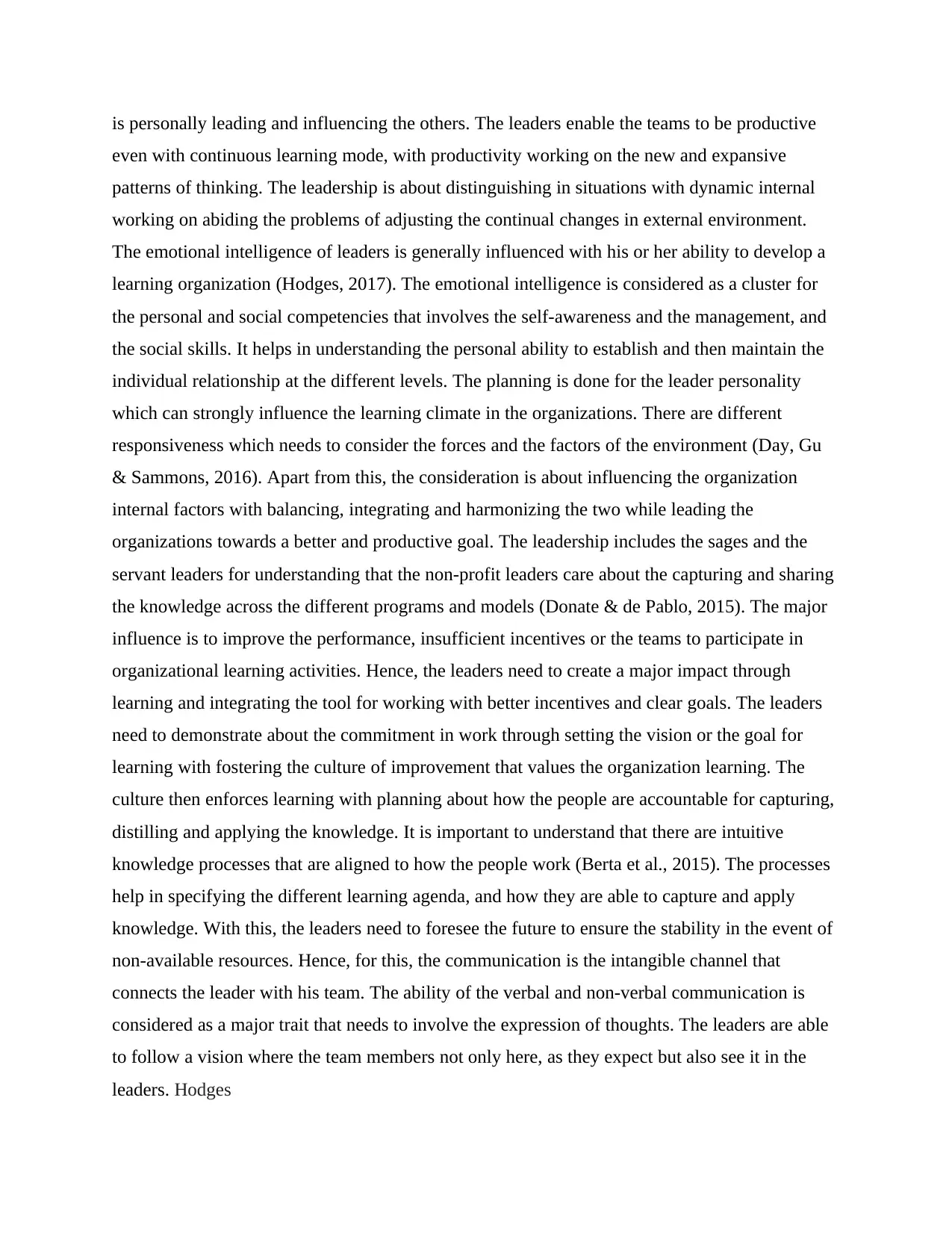
is personally leading and influencing the others. The leaders enable the teams to be productive
even with continuous learning mode, with productivity working on the new and expansive
patterns of thinking. The leadership is about distinguishing in situations with dynamic internal
working on abiding the problems of adjusting the continual changes in external environment.
The emotional intelligence of leaders is generally influenced with his or her ability to develop a
learning organization (Hodges, 2017). The emotional intelligence is considered as a cluster for
the personal and social competencies that involves the self-awareness and the management, and
the social skills. It helps in understanding the personal ability to establish and then maintain the
individual relationship at the different levels. The planning is done for the leader personality
which can strongly influence the learning climate in the organizations. There are different
responsiveness which needs to consider the forces and the factors of the environment (Day, Gu
& Sammons, 2016). Apart from this, the consideration is about influencing the organization
internal factors with balancing, integrating and harmonizing the two while leading the
organizations towards a better and productive goal. The leadership includes the sages and the
servant leaders for understanding that the non-profit leaders care about the capturing and sharing
the knowledge across the different programs and models (Donate & de Pablo, 2015). The major
influence is to improve the performance, insufficient incentives or the teams to participate in
organizational learning activities. Hence, the leaders need to create a major impact through
learning and integrating the tool for working with better incentives and clear goals. The leaders
need to demonstrate about the commitment in work through setting the vision or the goal for
learning with fostering the culture of improvement that values the organization learning. The
culture then enforces learning with planning about how the people are accountable for capturing,
distilling and applying the knowledge. It is important to understand that there are intuitive
knowledge processes that are aligned to how the people work (Berta et al., 2015). The processes
help in specifying the different learning agenda, and how they are able to capture and apply
knowledge. With this, the leaders need to foresee the future to ensure the stability in the event of
non-available resources. Hence, for this, the communication is the intangible channel that
connects the leader with his team. The ability of the verbal and non-verbal communication is
considered as a major trait that needs to involve the expression of thoughts. The leaders are able
to follow a vision where the team members not only here, as they expect but also see it in the
leaders. Hodges
even with continuous learning mode, with productivity working on the new and expansive
patterns of thinking. The leadership is about distinguishing in situations with dynamic internal
working on abiding the problems of adjusting the continual changes in external environment.
The emotional intelligence of leaders is generally influenced with his or her ability to develop a
learning organization (Hodges, 2017). The emotional intelligence is considered as a cluster for
the personal and social competencies that involves the self-awareness and the management, and
the social skills. It helps in understanding the personal ability to establish and then maintain the
individual relationship at the different levels. The planning is done for the leader personality
which can strongly influence the learning climate in the organizations. There are different
responsiveness which needs to consider the forces and the factors of the environment (Day, Gu
& Sammons, 2016). Apart from this, the consideration is about influencing the organization
internal factors with balancing, integrating and harmonizing the two while leading the
organizations towards a better and productive goal. The leadership includes the sages and the
servant leaders for understanding that the non-profit leaders care about the capturing and sharing
the knowledge across the different programs and models (Donate & de Pablo, 2015). The major
influence is to improve the performance, insufficient incentives or the teams to participate in
organizational learning activities. Hence, the leaders need to create a major impact through
learning and integrating the tool for working with better incentives and clear goals. The leaders
need to demonstrate about the commitment in work through setting the vision or the goal for
learning with fostering the culture of improvement that values the organization learning. The
culture then enforces learning with planning about how the people are accountable for capturing,
distilling and applying the knowledge. It is important to understand that there are intuitive
knowledge processes that are aligned to how the people work (Berta et al., 2015). The processes
help in specifying the different learning agenda, and how they are able to capture and apply
knowledge. With this, the leaders need to foresee the future to ensure the stability in the event of
non-available resources. Hence, for this, the communication is the intangible channel that
connects the leader with his team. The ability of the verbal and non-verbal communication is
considered as a major trait that needs to involve the expression of thoughts. The leaders are able
to follow a vision where the team members not only here, as they expect but also see it in the
leaders. Hodges
Paraphrase This Document
Need a fresh take? Get an instant paraphrase of this document with our AI Paraphraser
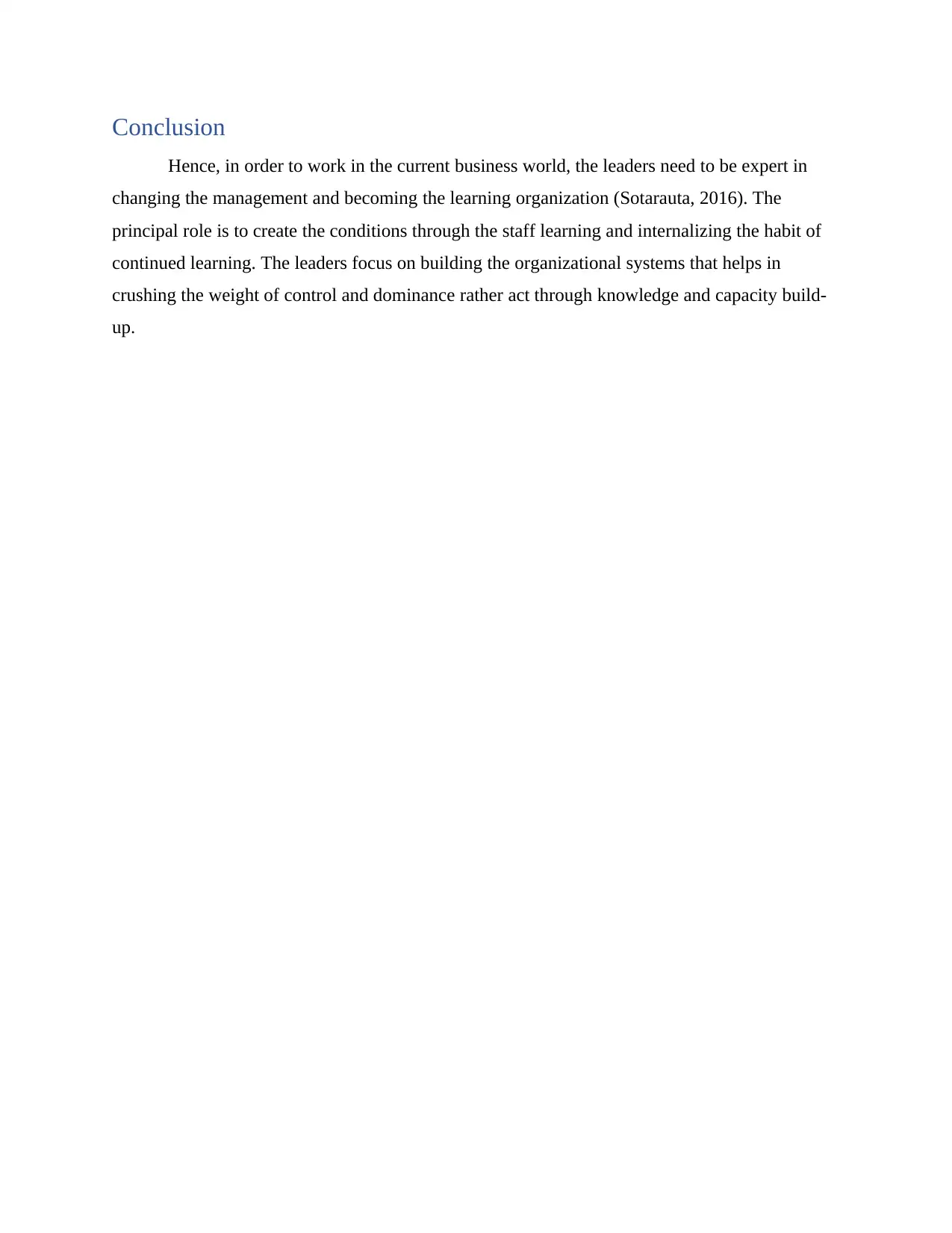
Conclusion
Hence, in order to work in the current business world, the leaders need to be expert in
changing the management and becoming the learning organization (Sotarauta, 2016). The
principal role is to create the conditions through the staff learning and internalizing the habit of
continued learning. The leaders focus on building the organizational systems that helps in
crushing the weight of control and dominance rather act through knowledge and capacity build-
up.
Hence, in order to work in the current business world, the leaders need to be expert in
changing the management and becoming the learning organization (Sotarauta, 2016). The
principal role is to create the conditions through the staff learning and internalizing the habit of
continued learning. The leaders focus on building the organizational systems that helps in
crushing the weight of control and dominance rather act through knowledge and capacity build-
up.
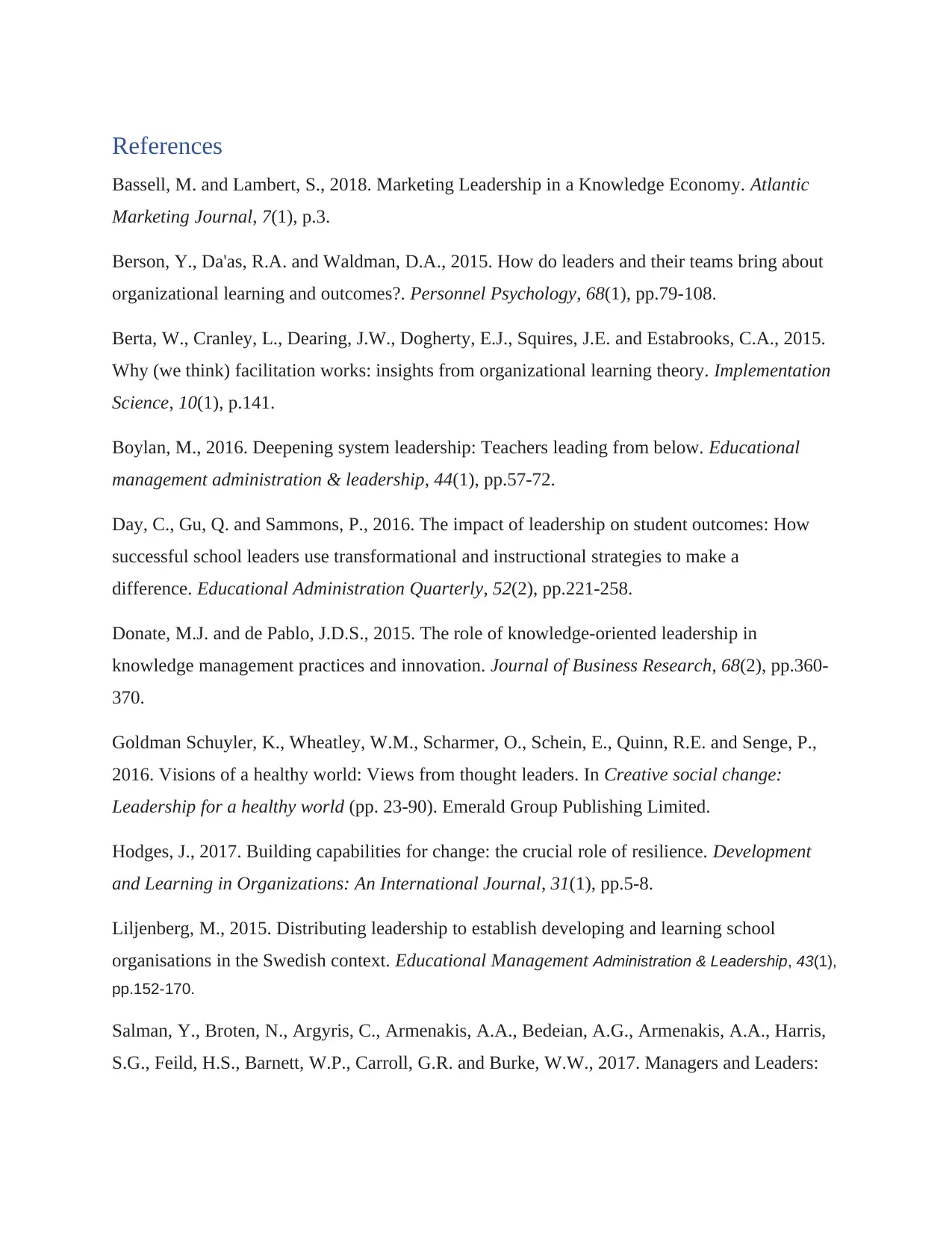
References
Bassell, M. and Lambert, S., 2018. Marketing Leadership in a Knowledge Economy. Atlantic
Marketing Journal, 7(1), p.3.
Berson, Y., Da'as, R.A. and Waldman, D.A., 2015. How do leaders and their teams bring about
organizational learning and outcomes?. Personnel Psychology, 68(1), pp.79-108.
Berta, W., Cranley, L., Dearing, J.W., Dogherty, E.J., Squires, J.E. and Estabrooks, C.A., 2015.
Why (we think) facilitation works: insights from organizational learning theory. Implementation
Science, 10(1), p.141.
Boylan, M., 2016. Deepening system leadership: Teachers leading from below. Educational
management administration & leadership, 44(1), pp.57-72.
Day, C., Gu, Q. and Sammons, P., 2016. The impact of leadership on student outcomes: How
successful school leaders use transformational and instructional strategies to make a
difference. Educational Administration Quarterly, 52(2), pp.221-258.
Donate, M.J. and de Pablo, J.D.S., 2015. The role of knowledge-oriented leadership in
knowledge management practices and innovation. Journal of Business Research, 68(2), pp.360-
370.
Goldman Schuyler, K., Wheatley, W.M., Scharmer, O., Schein, E., Quinn, R.E. and Senge, P.,
2016. Visions of a healthy world: Views from thought leaders. In Creative social change:
Leadership for a healthy world (pp. 23-90). Emerald Group Publishing Limited.
Hodges, J., 2017. Building capabilities for change: the crucial role of resilience. Development
and Learning in Organizations: An International Journal, 31(1), pp.5-8.
Liljenberg, M., 2015. Distributing leadership to establish developing and learning school
organisations in the Swedish context. Educational Management Administration & Leadership, 43(1),
pp.152-170.
Salman, Y., Broten, N., Argyris, C., Armenakis, A.A., Bedeian, A.G., Armenakis, A.A., Harris,
S.G., Feild, H.S., Barnett, W.P., Carroll, G.R. and Burke, W.W., 2017. Managers and Leaders:
Bassell, M. and Lambert, S., 2018. Marketing Leadership in a Knowledge Economy. Atlantic
Marketing Journal, 7(1), p.3.
Berson, Y., Da'as, R.A. and Waldman, D.A., 2015. How do leaders and their teams bring about
organizational learning and outcomes?. Personnel Psychology, 68(1), pp.79-108.
Berta, W., Cranley, L., Dearing, J.W., Dogherty, E.J., Squires, J.E. and Estabrooks, C.A., 2015.
Why (we think) facilitation works: insights from organizational learning theory. Implementation
Science, 10(1), p.141.
Boylan, M., 2016. Deepening system leadership: Teachers leading from below. Educational
management administration & leadership, 44(1), pp.57-72.
Day, C., Gu, Q. and Sammons, P., 2016. The impact of leadership on student outcomes: How
successful school leaders use transformational and instructional strategies to make a
difference. Educational Administration Quarterly, 52(2), pp.221-258.
Donate, M.J. and de Pablo, J.D.S., 2015. The role of knowledge-oriented leadership in
knowledge management practices and innovation. Journal of Business Research, 68(2), pp.360-
370.
Goldman Schuyler, K., Wheatley, W.M., Scharmer, O., Schein, E., Quinn, R.E. and Senge, P.,
2016. Visions of a healthy world: Views from thought leaders. In Creative social change:
Leadership for a healthy world (pp. 23-90). Emerald Group Publishing Limited.
Hodges, J., 2017. Building capabilities for change: the crucial role of resilience. Development
and Learning in Organizations: An International Journal, 31(1), pp.5-8.
Liljenberg, M., 2015. Distributing leadership to establish developing and learning school
organisations in the Swedish context. Educational Management Administration & Leadership, 43(1),
pp.152-170.
Salman, Y., Broten, N., Argyris, C., Armenakis, A.A., Bedeian, A.G., Armenakis, A.A., Harris,
S.G., Feild, H.S., Barnett, W.P., Carroll, G.R. and Burke, W.W., 2017. Managers and Leaders:
⊘ This is a preview!⊘
Do you want full access?
Subscribe today to unlock all pages.

Trusted by 1+ million students worldwide
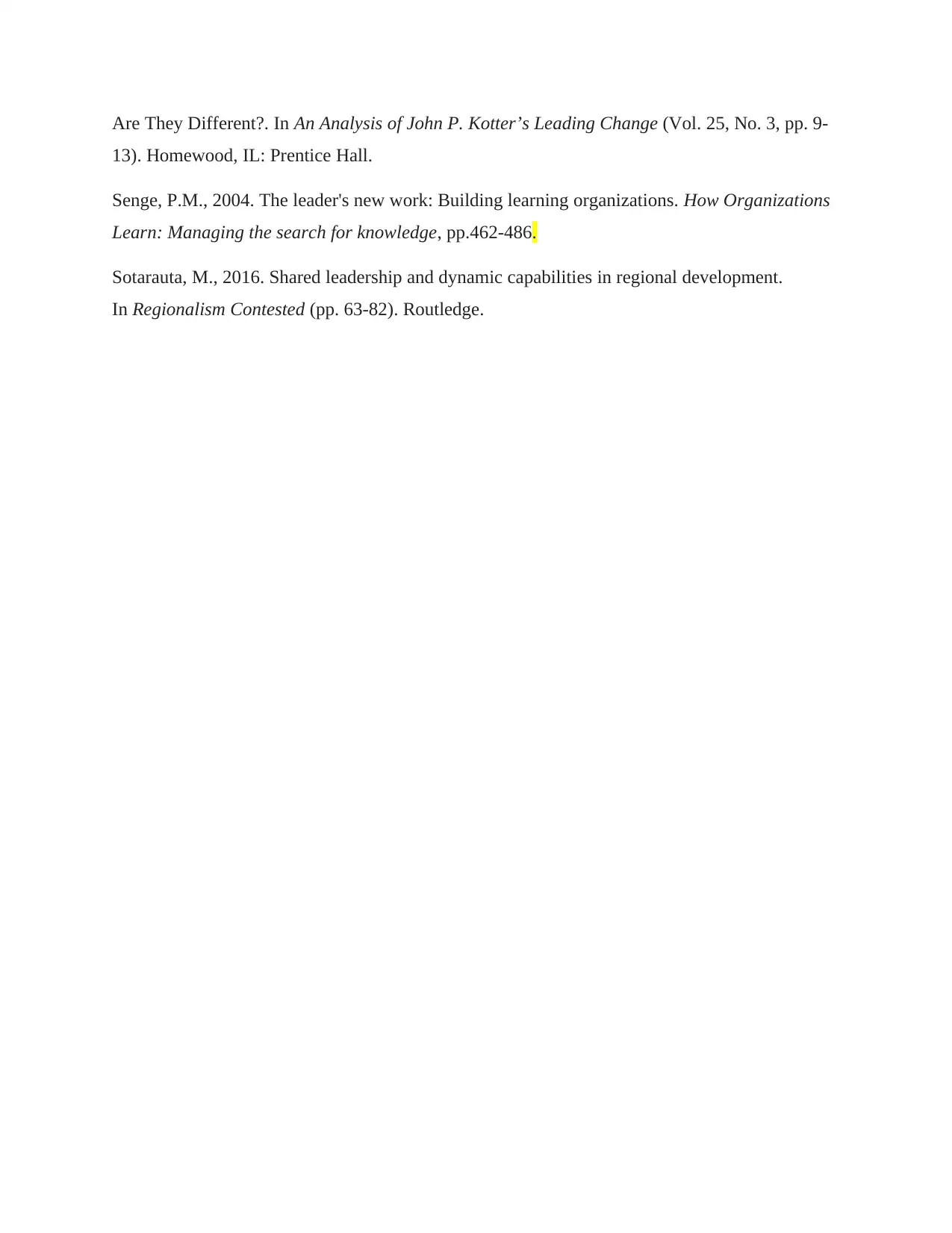
Are They Different?. In An Analysis of John P. Kotter’s Leading Change (Vol. 25, No. 3, pp. 9-
13). Homewood, IL: Prentice Hall.
Senge, P.M., 2004. The leader's new work: Building learning organizations. How Organizations
Learn: Managing the search for knowledge, pp.462-486.
Sotarauta, M., 2016. Shared leadership and dynamic capabilities in regional development.
In Regionalism Contested (pp. 63-82). Routledge.
13). Homewood, IL: Prentice Hall.
Senge, P.M., 2004. The leader's new work: Building learning organizations. How Organizations
Learn: Managing the search for knowledge, pp.462-486.
Sotarauta, M., 2016. Shared leadership and dynamic capabilities in regional development.
In Regionalism Contested (pp. 63-82). Routledge.
1 out of 7
Related Documents
Your All-in-One AI-Powered Toolkit for Academic Success.
+13062052269
info@desklib.com
Available 24*7 on WhatsApp / Email
![[object Object]](/_next/static/media/star-bottom.7253800d.svg)
Unlock your academic potential
Copyright © 2020–2025 A2Z Services. All Rights Reserved. Developed and managed by ZUCOL.





